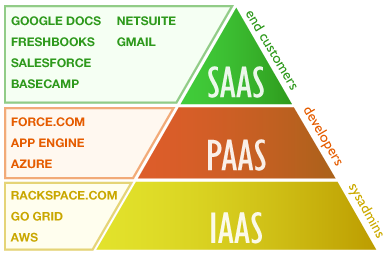Cloud computing offers three different types of services. Depending on the needs of users, each type of cloud computing service is used individually or in combination with others. Below is a summary of the three types of cloud computing services.
Software as a Service (SaaS)
SaaS is also known as “software on demand”. Instead of buying the software license completely, SaaS users rent it periodically and use it via an Internet browser. The variety of software made available by SaaS is very wide. A number of software products provided by SaaS are used by companies specializing in content management, human resources management, accounting, ERP, customer relationship management and other relevant areas.
The type of software-as-a-service cloud computing is growing very rapidly, while the largest market in the software-as-a-service market is customer relationship management.
Platform as a Service (PaaS)
(PaaS) provides computing platforms for cloud computing users. It is also the link between the two other services provided by cloud computing, namely SaaS and IaaS.
A normal computer requires a computing platform that includes a hardware architecture and a software infrastructure. Such a platform is the basis for collaboration of hardware and software including the operating system, architecture and languages of the computer. Thus, in the case of cloud computing, in the absence of a real computer, it is the platform as a service that provides the users with everything necessary to compose an IT platform.
PaaS features include hosting, deployment, testing, application development and application design. In addition, PaaS cloud service providers include a number of features to design, test, deploy, host and run applications. All these facilities can be used by individual or professional customers by subscribing to a single package with all features included.
Infrastructure as a Service (IaaS)
IaaS is the third type of cloud computing. Just as PaaS and SaaS provide different software and hardware installations based on a cloud platform, IaaS provides a virtualized platform. The hardware virtualization process only shows users the abstract computing platform instead of the physical features. Such virtualization leads to the creation of a so-called “virtual machine monitor” or “hypervisor” that allows the creation of the third part of cloud computing, namely the interface as a service.
The infrastructure that becomes available to Interface users as a service includes software, servers, network equipment, and data center space. The cost charged by cloud service providers to customers usually depends on the amount of user activity and therefore is not fixed. There is however a minimum amount of charge depending on the number of installations that a user has also subscribed.
The use of this computer technology has many advantages. However, each type of service has its own advantages and disadvantages. In order to make the right decision, it is imperative that users carefully weigh the pros and cons.
